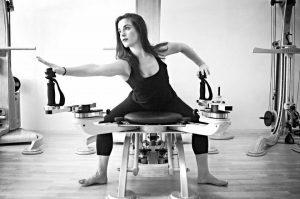
By Claudie Benjamin
Every exercise therapy has its own philosophy and discipline. Some have hallmark equipment designed to train the body in specific ways. Trainers and enthusiasts of particular techniques talk about finding what’s right for them in helping them feel better. Identifying just the right therapy and therapist/trainer of course makes all the difference. The process often comes by way of trial and error but finding the means to relieve pain and increase body strength, and ease of relaxed movement is hugely satisfying.
Rebecca Correia, a ballet dancer and GYROTONIC® instructor opened Étude 72 at 133 West 72nd Street, in July 2020. She knew that launching her own business during the Covid period would be fraught with uncertainties. But, she was determined to persevere.
After obsessing over the financials, weighing pros and cons with her boyfriend, she concluded that if she offered training via Zoom and provided one-on-one instruction while paying great attention to distancing, sanitizing and good ventilation and taking Covid screening tests at mobile vans frequently, she could offer a rewarding service that would attract clients.
This approach has been working well. Correia is working seven days a week. Some clients come for one session a week, others make two or three other appointments a week. She assigns “homework” exercises that can be done outside the studio, for those who can only come in every week or so. Correia explains, drawing elements from swimming, tai chi, ballet and modern dance, the fluid, undulating movement that comes with the Gyrotonic technique, “can feel like dance.” When her studio empties of students, she uses the time to do her own dance.
Achieving fluid, gentle movements that exercise every part of the body is the GYROTONIC® goal. Like Pilates, which evolved in the 1920s, the newer GYROTONIC® technique that developed in the 1970s, uses trademarked equipment fitted with pulleys and weights to help participants achieve therapeutic goals.
Correia explains that Pilates emphasizes linear up and down movements. In contrast, the GYROTONIC® approach is conceived to be more three-dimensional. A piece of equipment called The Tower is used to strengthen the body by way of circular, rotating, twisting and turning movements. Correia also trains clients on another machine called the Galileo. This consists of a vibrating plate that can be set to create varying levels of mechano-stimulation to help create better muscle tone as well as mobility. The goal here is to address problems of balance, help stabilize the joints and build strength. Correia’s clients range from children who learn the basics of ballet to an 86 -year-old who finds that training in the GYROTONIC ® approach to movement relieves her chronic lower back pain. Some variation of this equipment makes training possible while sitting on a stool. The mat version of GYROTONIC® is called GYROKINESIS®, which is what she teaches to her Zoom clientele.

Rebecca Correia outside 133 West 72nd Street
Correia is a transplant to the Upper West Side from a small town near San Diego, California, where she grew up. Trained as a dancer, she has performed with the
Boston Ballet and as a soloist with the California Ballet Company. She learned about the GYROTONIC® discipline from a dance instructor and found it was helpful in achieving greater subtlety and fluidity of movement. Having moved to NYC and settled into an apartment on West 108th Street and Manhattan Ave., she realized she loved New York and all its cultural richness but could not count on dancing alone to pay the bills.
She says she loves teaching, helping clients achieve their exercise goals and especially working one on one. Her studio is open airy and quiet, looking out on her neighbors’ brownstone yards. “It’s a very Zen space,” she says. Possibly one day, she’ll expand her service but for now she’s just pleased her enthusiastic following is spreading the word. “People leave this class happier; they are enjoying being conscious of moving gracefully through their day whether reaching for a jar on the shelf, running to take the dog out for a walk or picking up a pot from the stove.”
